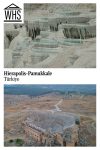Hierapolis-Pamukkale
By Cindy Carlsson
What is Hierapolis-Pamukkale?
Hierapolis-Pamukkale is a Greco-Roman spa town (Hierapolis) and the enormous calcium terraces, waterfalls, basins, and pools (Pamukkale) where it is located.
Hierapolis was first built by the kings of Pergamon beginning in the 2nd century BC and remained an important site through the 7th century. The town site includes the ruins of baths, temples, a theater, two cemeteries, and other structures and monuments, including a vast hydraulic system.
Disclosure: This article contains affiliate links. Making a purchase through an affiliate link will mean a small commission for this website. This will not affect your price.
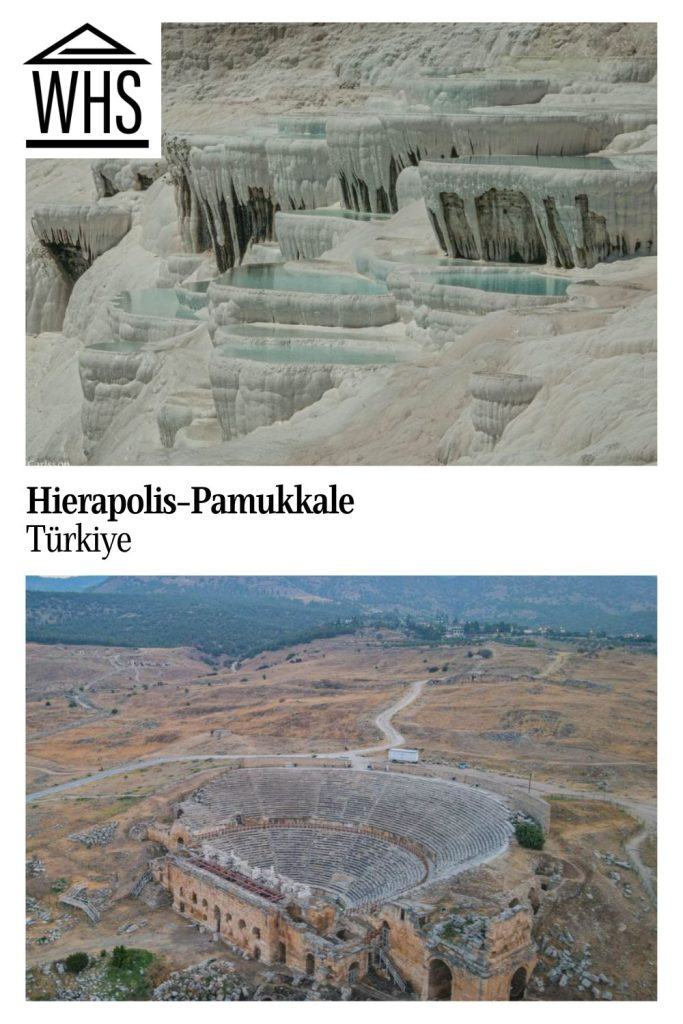
Pamukkale (the “Cotton Palace” in Turkish) is both a beautiful and surreal landscape that still draws visitors to its stunning natural terraces and mineral-rich basins and pools.
Why is Hierapolis-Pamukkale a UNESCO World Heritage site?
This site is important for the Greco-Roman architecture and monuments documenting pre-Christian and Christian cultural and religious practices, as well as its “visually stunning” landscape.
UNESCO describes Hierapolis-Pamukkale as “an exceptional example of a Greco-Roman thermal installation established on an extraordinary natural site.”
Besides the Greco-Roman monuments, the site contains Christian monuments that are “an outstanding example of an Early Christian architectural group with a cathedral, baptistery and churches.”
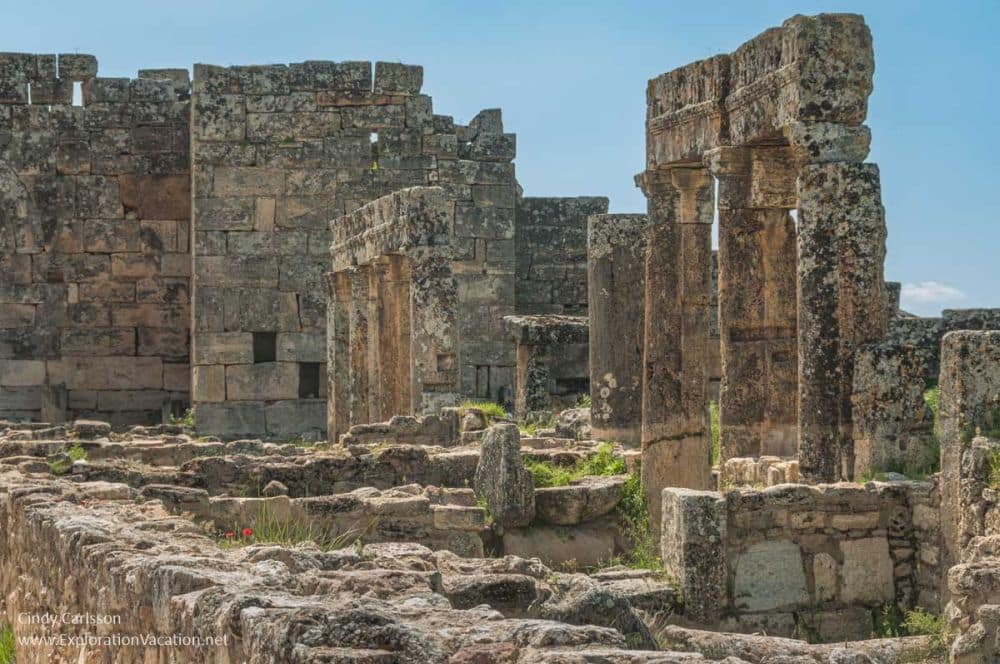
What can you expect on a visit to Hierapolis-Pamukkale?
Pamukkale
You see Pamukkale long before you actually arrive. Running about 2,700 meters (over 1½ miles) long and more than 150 meters (more than 500 feet) high, this limestone formation is truly massive. On a clear day you see it floating in the distance many miles before you actually reach it.
You can approach the terraces from above or below, and a path lets you move in through the formation in either direction. After decades of water diversions from the springs that feed Pamukkale’s terraces and thousands of visitors tromping through them, most are now dry and/or off-limits. However, a few pools are maintained specifically for visitors to wade in. (None are deep enough for swimming.) And you should wade in the silty blue water where it is allowed. Just be cautious, as the wet limestone is very slippery!
Despite the crowds and closures, this is still an amazing and beautiful place.
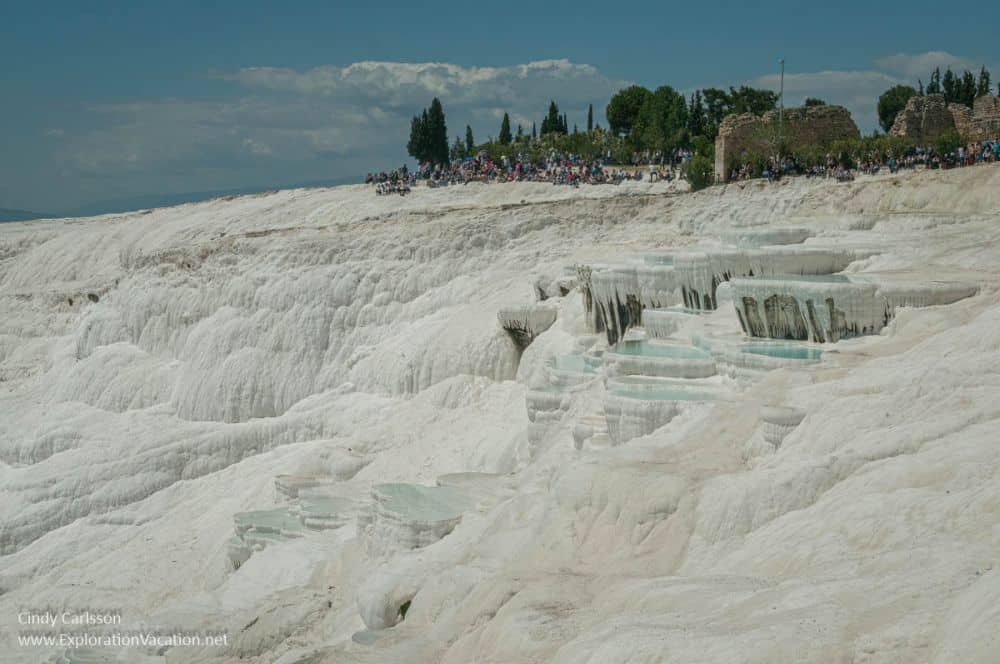
Hierapolis
The ruins at Hierapolis are a mix of Greco-Roman (Hellenistic and Roman) and Christian structures and monuments. With the exception of early Hellenistic tombs, most Greco-Roman ruins date to the site’s peak during the 2nd and 3rd centuries AD. (After it was rebuilt following a devastating earthquake.) Christian ruins are generally from the 4th and 5th centuries when this was an important religious outpost. In the 7th century the town was destroyed by a combination of warfare and another earthquake. After that, the town never really recovered and the site was completely abandoned after an earthquake in 1334 destroyed what remained.
You can get to the main part of the ancient city quickly and easily from the south entrance. But this is also the busiest entrance, so my tour dropped us off on the opposite side of the site. This put us at the far end of the North Necropolis. This is said to be one of the largest cemeteries in Türkiye and has tombs dating back to the spa’s founding in the 2nd century BC. And it’s a long walk from here to the old city gate. However, the wide variety of tombs along the way, spring flowers, and stunning views of the mountains make it a pleasant walk on a nice day.
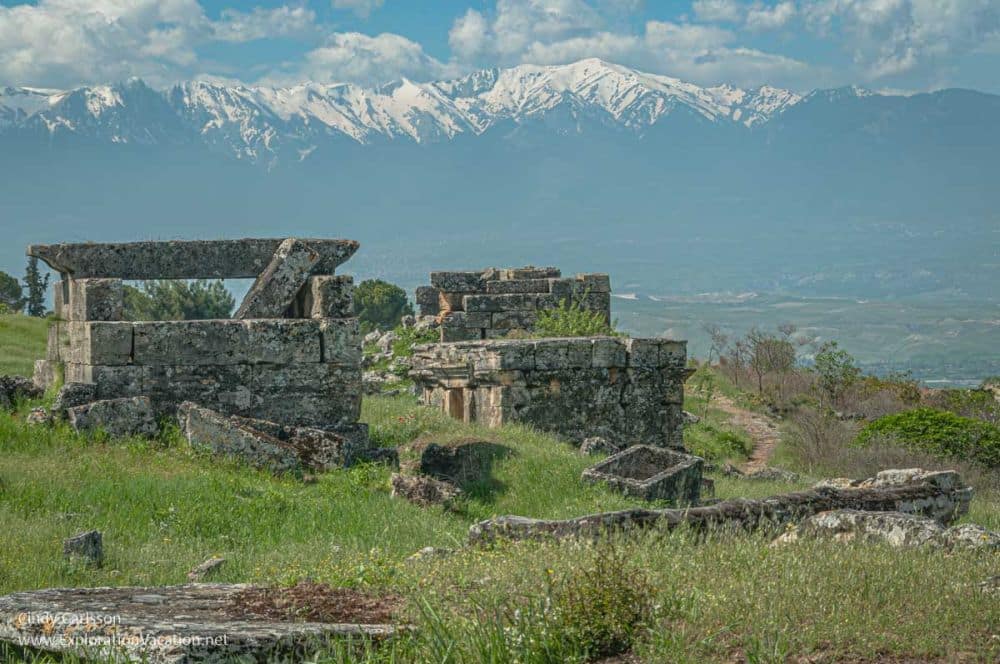
The ruins of Hierapolis include several large ancient gates. Wherever you begin, you’ll eventually pass through at least one of these gates as you enter and explore the ruins of the city. In and immediately around the city itself you’ll find the ruins of temples to Apollo and Pluto, latrines, baths (one of which was converted to a now-ruined basilica under the Byzantine empire), gymnasium, theater, and more. On-going excavation and restoration mean ruins are constantly being excavated while others are being stabilized and restored.
The theater is the most dramatic structure at Hierapolis. It is also one of the best-preserved Roman theaters in Türkiye. Built into the hillside, it also has to be one of the steepest Roman theaters anywhere! It was fully restored (the stage area has replicas of some original features) and is occasionally used for concerts and other events.
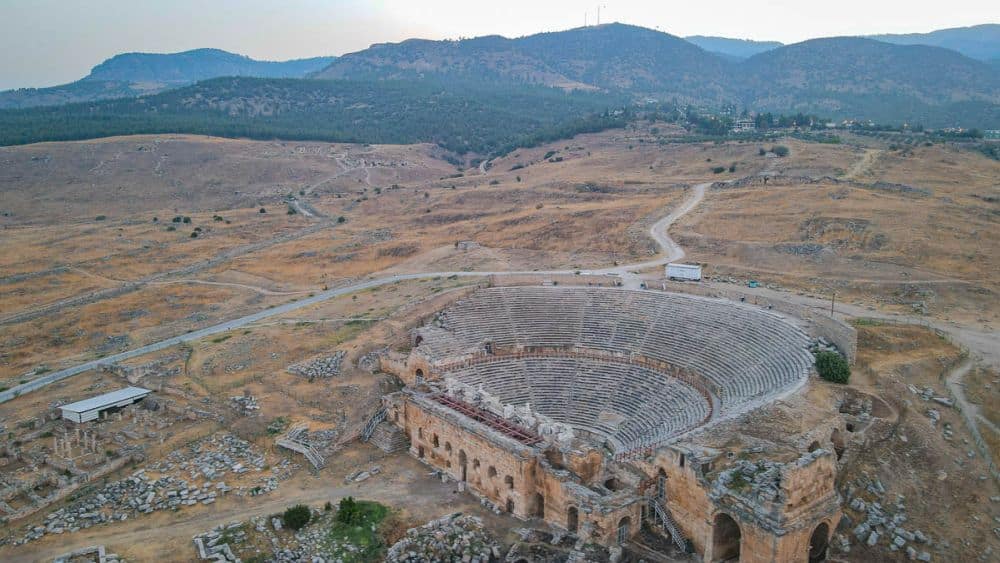
The city’s central Roman baths now house the Hierapolis Archaeology Museum. The museum exhibits artifacts from Hierapolis, as well as items from other archaeological sites in the region. Exhibits include tombs and statues, small artifacts that represent 4,000 years of history and several civilizations, and decorative features from the theater. (The theater still has some of its original sculpture and other decorative features, but others are displayed here, with copies installed at the theater.)
Outside the city gates and up a steep hill, the Saint Philip Martyrium is the site’s most important Christian ruin. It’s an unusual octagonal building surrounded by a mix of rectangular, triangular, and other polygonal rooms to form a square. The wooden roof is long gone, but the layout is clear and the view over the surrounding area is said to be fantastic. But it is a long climb up.

Cleopatra’s Antique Pool
I didn’t get to visit the Antique Pool, but it looks lovely. This small lake was created by earthquakes and then enhanced in antiquity for use as a thermal pool. A temple once stood over it, but that collapsed into the pool itself. Today visitors to this mineral-rich hot spring swim around the temple ruins. It’s located just outside the gates of the city of Hierapolis.
Are Hierapolis and Pamukkale worth visiting?
For most visitors, Hierapolis-Pamukkale (particularly Pamukkale) is the reason they have left the coast to come to this region of Türkiye. But it’s easy enough to get to and is a huge draw for Turkish visitors. On tours, it’s often included as a stop when traveling between Ephesus and Göreme National Park and the Rock Sites of Cappadocia.
If you already plan to visit Izmir or Ephesus or elsewhere in this part of Türkiye, it is definitely worth adding Hierapolis-Pamukkale to your itinerary. Overall, the Greco-Roman ruins may not be as impressive as others you’ve seen. However, you’re unlikely to have seen anything like Pamukkale. This is a massive formation that glows in the sunlight. It’s stunning. (If you’ve seen Mammoth Hot Springs in Yellowstone National Park, it’s the same process. Only Pamukkale is much bigger, with bright white terraces and shimmering blue pools.)
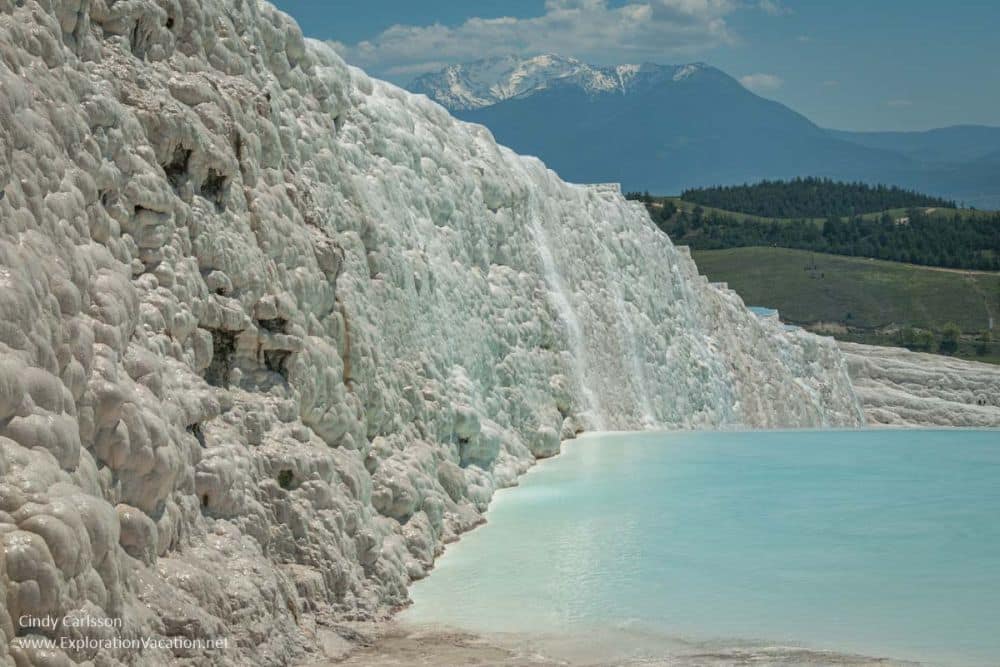
Allow at least an hour to visit the terraces, longer if you want to relax in one of the pools or just spend time marveling at the site’s strange beauty. Expect to spend a couple of hours just walking through Hierapolis, and longer if you want to hike up to the Martyrium and take your time in the museum. Of course, it would be easy to spend a full day exploring and relaxing at Hierapolis-Pamukkale.
What sorts of travelers would like Hierapolis-Pamukkale?
As a site with an unusual and strikingly beautiful natural feature, many Greco-Roman ruins, and a mineral-rich pool where you can swim among Roman ruins, there should be something here for everyone.
Tips for visiting Hierapolis-Pamukkale
Most visitors arrive by mid-morning and the site remains very busy until late afternoon. For a better experience, stay overnight in town and visit the terraces and ruins before most Turkish visitors and foreign tour groups arrive.
Find accommodations in Pamukkale here.
A single ticket lets you enter Pamukkale’s terraces, Hierapolis, and the archaeological museum. The Antique Pool charges an additional fee if you want to swim there.
There is no shade at either Hierapolis or Pamukkale. Both sites can get brutally hot, and the glare from the sun can make Pamukkale pretty unbearable on a sunny summer day. Bring a hat and sunscreen on sunny days.
Visitors are only allowed in a few pools, as many have been damaged over the years. Stay out of areas that are closed! (Bring a camera with a telephoto lens if you want great photos of glistening blue pools with no one in them, as they may be far from the areas you are allowed to enter.)
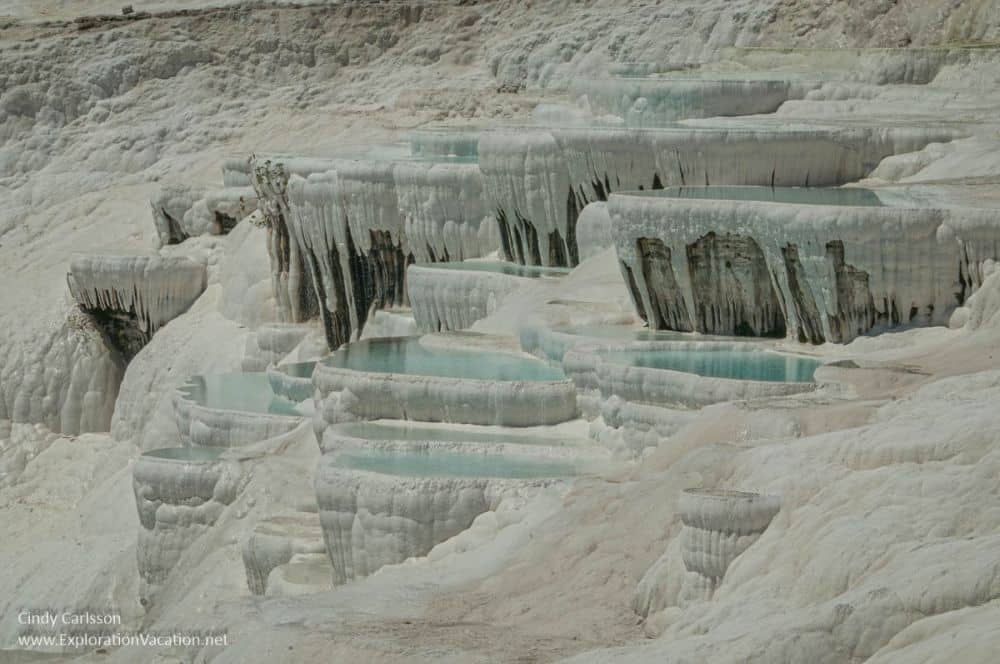
Shoes are not allowed anywhere on the terraces. Not even where it is dry.
While the terraces are slippery wherever there is water, don’t be afraid to step into flowing water or pools. Just step carefully. (I’m pretty clumsy and I managed to move around the site and through pools with a clunky camera amid a huge crowd without falling. But it was a little tricky and I saw plenty of others fall.)
There is nowhere to store items at Pamukkale. It’s best to bring a waterproof bag for your shoes, phone, and other items you want to keep dry – even if you don’t plan to get wet.
If you do plan to get wet, wear your swimsuit to the site and bring a towel or buy one in town. (You can usually buy one at the Antique Pool, but you’ll pay dearly.) You can change back out of your swimsuit at the Antique Pool.
Wheelchair users can see large portions of both sites, although there is no wheelchair access to Pamukkale’s pools.
It’s relatively easy to combine a visit to the Hierapolis-Pamukkale World Heritage Site with the UNESCO World Heritages sites of Ephesus and Aphrodisias. Plenty of tours are available that combine sites. Click on the image below:
Where is Hierapolis-Pamukkale?
Hierapolis and Pamukkale are in southwest Türkiye. You can easily find the location of specific sites within this World Heritage site on Google Maps.
There’s a small city called Pamukkale right by the terraces. It has a few hotels and restaurants and is the most convenient place to stay because you can walk from your hotel to the UNESCO site. But lodging options are limited, so most visitors stay 20 minutes away in Denizli.
Find accommodations in Denizli here or use the map below:
Thanks to Turkish Airlines, Türkiye has international connections to many airports. That includes airports in Izmir, Bodrum, and Antalya. There’s also a regional airport in Denizli.
Pick up a rental car on arrival.
To get to Denizli by car or transit:
- From Ephesus, it’s about a 2½ hour drive (about 200 km or 120 miles) almost due east on major roads. The train takes around 3½ hours to make the trip.
- From Antalya, the drive is about three hours (250 km or 150 miles) north and slightly west. There’s no train on this route, but there is bus service.
- From Bursa, it’s a five-hour drive, an eight-hour bus ride, or use a combination of transportation options. Add another 1½ to 3 hours to drive or travel by transit from Istanbul.
From Denizli, the drive to Hierapolis-Pamukkale takes 15-20 minutes. Regular bus service operates between Denizli and the north entrance.
There are three entrances to this site:
- The south gate, where tour buses and vehicle traffic coming from Denizli enter. This is the busiest entrance. It also has a visitor center and is closest to the major attractions. Parking is available for a fee.
- The Pamukkale town entrance is within walking distance of hotels in town. However, it is a long (but scenic) walk to most attractions from here. Vehicles have no access to this entrance, although vehicles can access other areas in town. Don’t expect to find free parking unless you are staying in town.
- The north entrance is accessible by car or taxi. From here it’s about a 1 km (over a half-mile) walk through the northern necropolis just to get to the main ruins. The Antique Pool and Pamukkale’s terraces are farther still. However, there’s also a visitor center and paid parking at this entrance.
For more information about Hierapolis-Pamukkale, its opening hours, and admission fees, see the official Hierapolis website.
Have you been to Hierapolis-Pamukkale? If so, do you have any additional information or advice about this UNESCO World Heritage site? Please add your comments below!

